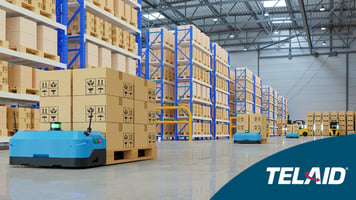 Retail distribution channels are just one more facet of the retail industry rocked by the pandemic. Game-changing trends were already on course to impact retail, but the pandemic accelerated change, triggering an urgent assessment of retail distribution, how it’s done, and the technologies used.
Retail distribution channels are just one more facet of the retail industry rocked by the pandemic. Game-changing trends were already on course to impact retail, but the pandemic accelerated change, triggering an urgent assessment of retail distribution, how it’s done, and the technologies used.
3 big trends that changed retail distribution
Between an unpredictable economy, historic global pandemic and unprecedented digital transformation, a dynamic environment is keeping retailers on their toes. Here are three key trends that have triggered the need for retail distribution center overhaul.
- Sudden shift to e-commerce – According to data from Adobe Analytics, orders placed online for curbside pickup increased 208% in 2020. And as of June 2023, half of consumers plan to boost their online spending over the next six months, according to a PwC survey. Online orders demand that retailers deliver a consistent and convenient customer experience, meaning that merchandise has to be easily located and assembled for pickup.
- Erratic consumer demand - First it was supply chain disruption triggered by COVID-19 shutdowns worldwide. Retailers stocked up on inventory in hopes of avoiding out-of-stocks. In a 2023 Survey of Retail CFOs, 82% of those surveyed said that supply chain disruption poses a significant risk to their business. Then, major shifts in consumer purchasing behavior saddled retailers with excess inventory, causing 34% of CFOs in that same BDO survey to indicate that they are facing extensive excess in inventory in 2023. Retailers need supply chain visibility to better understand, forecast and react to disruptions.
- Demand for speed – Increasingly, shoppers expect their orders to be prepared and shipped on demand. Speed, in turn, requires information, and information requires real-time systems.
What can retailers do to improve distribution center efficiency?
In light of new conditions and demands, retailers are embracing new strategies to ensure the efficiency of their distribution channels. Here are some recommendations for fully optimizing retail distribution centers.
- Invest in automated micro-fulfillment centers – The rise of micro-fulfillment centers and new distribution centers reflects the urgent need for retailers to build spaces optimized for inventory sorting, packing and delivery in a localized area. Automation technologies in these centers enable more streamlined, accurate and cost effective order processing and delivery. According to Chainalytics, an automated micro-fulfillment center can reduce the cost of processing an order from $10-$15 down to $3-$6 — a savings of over 60%.
- Data-driven decision making – Integrated systems can provide better data for real-time visibility and informed decision making. By harnessing advanced analytics and insights, retailers can better understand changing consumer behaviors, optimize inventory allocation, and tailor distribution strategies to specific market segments. This data-driven approach helps retailers adapt distribution networks to meet evolving consumer needs, enhance operational efficiency and drive customer satisfaction.
- Leverage AI to reduce returns – While many retailers spend their time and energy on the last mile, reverse logistics are increasingly critical to delivering a desirable customer experience. When it comes to returns, AI is an extremely valuable tool. On the front end, AI can help determine if the product is a good fit for the customer. This could be literal fit, as in apparel, or product desirability fit based on other purchases and returns. By helping consumers make better pre-purchase decisions, retailers can reduce the number of returns made. AI can also provide retailers with a by-the-order decision on the most cost effective way to deal with a return, whether it’s replacement, repair or order cancellation if computer vision identifies an incorrectly packaged or broken product before shipment.
Dozens of retail technologies combine to achieve optimal efficiency in retail distribution centers. Telaid designs, deploys and supports all of these technologies to keep efficiency high and costs low. Start a conversation with us about how to build out distribution capabilities that meet the demands of the market today.




